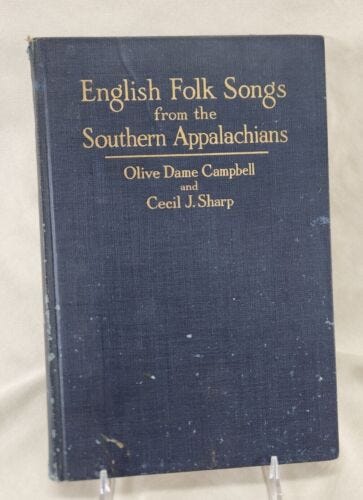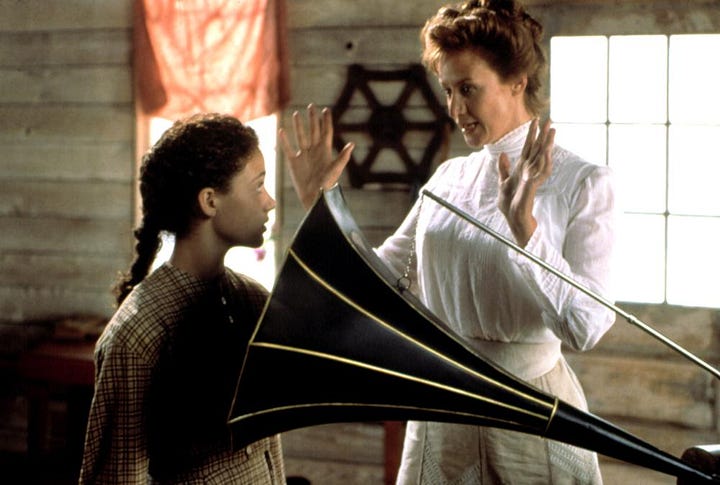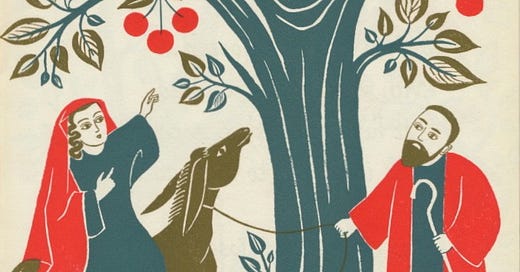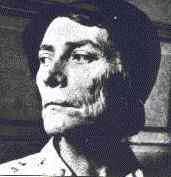Aunt Molly Jackson was born in Clay County, Kentucky in 1880, one of fifteen children. Her great-grandmother sang to her, and her daddy sold groceries to coal miners and pastored a Missionary Baptist church, “preaching one sermon on Saturdays and two on Sunday, and at night organizing the miners.”1 Aunt Molly – who was born Mary Magdalene Garland, and died Mary Magdalene Garland Steward Jackson Stamos – married at 14, had two children, and spent the next decade as a midwife, delivering some 884 babies. After her husband was killed in a mine accident in 1917, and her father and brother were blinded in another mining accident, she became a member of the United Mine Workers and started writing protest songs.
Union work took her to New York (that is to say — Kentucky banished her for being a communist organizer), where she began collaborating with Woody Guthrie and Pete Seeger.2 Folklorist and ethnomusicologist Alan Lomax recorded her for the Library of Congress in the 1930s, and one of the songs she sang was “Joseph and Mary,” also known as “The Cherry Tree Carol.” Its lyrics tell of the couple walking through an orchard where the trees hang heavy with ripe fruit. A pregnant Mary asks a much-older Joseph to gather some cherries for her, and he says, basically, let the baby’s actual father do the work. Jesus then intervenes from the womb, commanding the cherry trees to bow down so Mary can reach the fruit. Mary gathers cherries, while Joseph “stands around.” (At women’s Bible study, the 80 year old woman next to me started giggling at this part, and a woman on the other side of the table said, “And probably standing right in the way of where you need to be.” “And Mary diced the onions, while Joseph watched the game.”) After this, Mary and Joseph reconcile, and together they look forward to the day when all creation will tremble with joy at Jesus’ birth.
You can hear Aunt Molly sing her version at the Lomax Kentucky Recordings, or you can listen to my favorite contemporary version from Elizabeth Mitchell here, or listen to any number of recordings on Spotify.3 4
When Joseph was an old man, an old man was he
He married virgin Mary, the Queen of Galilee
Joseph and Mary walked through an orchard green
There were cherries and berries as slick as might be seen
Mary said to Joseph so meek and so mild
Joseph gather me some cherries, for I am with child
Then Joseph flew in anger, in anger flew he
Let the Father of the baby gather cherries for thee
Then up sprung Baby Jesus from in his Mother's womb
Said "bow low, low cherry tree, bow low down to the ground"
Then the cherry tree bowed low down, low down to the ground
And Mary gathered cherries, while Joseph stood around
Then Joseph took Mary upon his right knee
He said "Tell me, pretty baby, when your birthday shall be"
On the sixth day of January, my birthday will be
When the stars and the elements shall all tremble with glee
When Joseph was an old man, an old man was he
He married virgin Mary, the Queen of Galilee
I like to listen to Aunt Molly’s Appalachian warble and imagine how the words felt to one who had been a coal miner’s daughter poor and pregnant as a teenager, who had attended almost a thousand births (at a time when at least six to nine women out of every thousand died of pregnancy-related complications, and approximately 100 of every thousand infants died before age one — national statistics that were almost certainly worse in coal country), who herself had been married three times. How did it feel to identify with another poor, hungry, pregnant teenager named Mary living in an exploited community — and to call her the Queen of Galilee? How did it feel to see all creation trembling for Jesus to come, after observing the earth’s trembling in the coal mines? What men did she remember speaking dismissively and in anger to her? And who had spoken up on her behalf when they did? Where had Jesus been then?
Lomax, traveling through Appalachia with his phonograph, recorded two other versions of the song along with Aunt Molly’s, and a few years earlier, James Madison Carpenter recorded an 80 year old man named Henry Thomas from Cornwall, England singing a version which came from his great-grandmother who lived in the 1700s; apparently, this song is one of the many English folk songs passed down in Appalachia (Aunt Molly’s ancestors came from England to America in 1637).5 In 1951, Peter Pauper Press published a wordless picture book based on it, and the song reached its height of popularity in the States after Joan Baez recorded it in 1961.
But the song’s origins likely lie much farther back in history. An article in Biblical Archeology Review suggests that this song sprang from Syria in the fifth century over to England in the Middle Ages, carried by Crusaders, before it migrated to the Americas.
Though there’s nothing in the Bible that suggests that Joseph was petty or mean or combative — “Joseph, being a righteous man and unwilling to expose her to public disgrace, planned to dismiss her quietly,” Matthew writes — the apocryphal 2nd century Infancy Gospel of James paints a slightly different picture.
In the sixth month of her pregnancy, Joseph came from his house-building and went into the house to find her swelling. And he struck his face and threw himself on the ground in sackcloth and wept bitterly, "… Has not the story of Adam been repeated with me? For while Adam was glorifying God, the serpent came and found Eve alone and deceived her and defiled her - so it has also happened to me."
And Joseph got up from his sackcloth and called her and said to her, "After having been cared for by God, what have you done? Did you forget the Lord your God?
…Then, she wept bitterly, saying, "I am pure and I did not know a man."
It may have been this story that inspired the 5th century Syriac dialogue hymn “sung in church by twin choirs—one singing the part of Joseph; the other, Mary—as part of the Christmas liturgy… but in this Syriac drama, Mary holds her own and does not falter. She even proves herself an adept Biblical scholar: “You have gone astray, Joseph; take and read for yourself in Isaiah it is written all about me, how a virgin shall bear fruit.”(The women in women’s Bible study loved that. So do I.)6
This Syriac dialogue hymn was likely observed by Crusaders who brought it back to England in the 12th century, where it was adapted to become part of the developing English Mystery play tradition, and eventually the Cherry Tree Carol. Which — with fifth century origins — makes it one of our very oldest Christmas songs.7
***
In the Infancy Gospel of James account, Joseph goes all the way back to the garden of Eden, claiming that Mary is just another foolish Eve, seduced by a snake.
“The Cherry Tree Carol” takes us back to the garden, too. But — as Mary Joan Winn Leith writes in Biblical Archeology — this time, we see Mary reversing the curse, not re-living it. “Mary and Joseph in the cherry orchard recalls, of course, Adam and Eve in the Garden of Eden. There, trouble with fruit led to big trouble for humanity, trouble that the baby in Mary’s womb will set right. In this somewhat feminist counter-story, a man is put in his place by a woman—with God’s full cooperation!”
As Adam and Eve left the garden, God told them they would struggle to relate to each other, and they would toil and labor to grow food from the land. But in this song, Jesus-in-utero is already healing both kinds of damage. The cherries willingly drop into Mary’s hands, and then Joseph takes her on his knee. The day is coming when our relationships will be mended, when all the stars and elements will tremble with glee, heaven and nature sing, the trees of the field clap their hands, and the land will give us grain and oil and wine to offer back to God, for Jesus is being born.
Until that time? We sing our protest songs, and our hopeful hymns.
Three Things:
Image invites you to an Advent art salon, with a variety of guests sharing poetry, music, and a meditation from friend of the ‘stack Bobby Gross. Wednesday, December 13, 2 pm Pacific / 5 pm Eastern, on Zoom. Register here.
Leslie Jamison on trying to complete her friend’s novel. Friendship, creativity, and absence, some of my favorite heartbreaking themes. (PS: if you don’t subscribe to The New Yorker, did you know that you can often read it free on Libby? It’s hard to read on a phone, but it’s great on a tablet.)
Nearly five hours of Sufjan’s Christmas music, set to video of a blazing yule log.
Where Goodness Still Grows is available wherever books are sold. Dangerous Territory is now available in an updated second edition and as an audiobook! Buy it in paperback or ebook at Bookshop, Amazon, or Barnes and Noble.
https://www.jstor.org/stable/pdf/3051817.pdf?refreqid=fastly-default%3Acbb19bbbda426f81951f27006267d3b3&ab_segments=&origin=&initiator=&acceptTC=1
And why do we know their names and not hers?
This whole album is beautiful, highly recommend. We have loved it since it came out a decade ago.
And if this kind of woman-focused music history is interesting to you, you have to listen to the Wildwood Flower podcast.
Songcatchers in the 1910s had recorded and published some of these songs, a story dramatized in the movie Songcatcher.


https://www.biblicalarchaeology.org/daily/biblical-topics/post-biblical-period/the-origins-of-the-cherry-tree-carol/. You can read the full text of the Syriac hymn by downloading a PDF… to be honest, the connection may be a bit of a stretch.
This also helps explain why Jesus’ birthday is listed as January 6. The Jerusalem church observed Christmas on January 6 up until 548 CE.







Brilliant and beautiful.
Thank you, Amy, for enlightening and inspiring me.